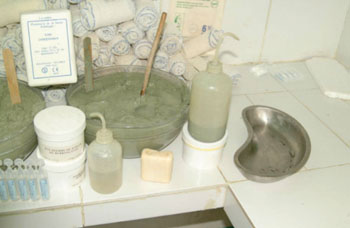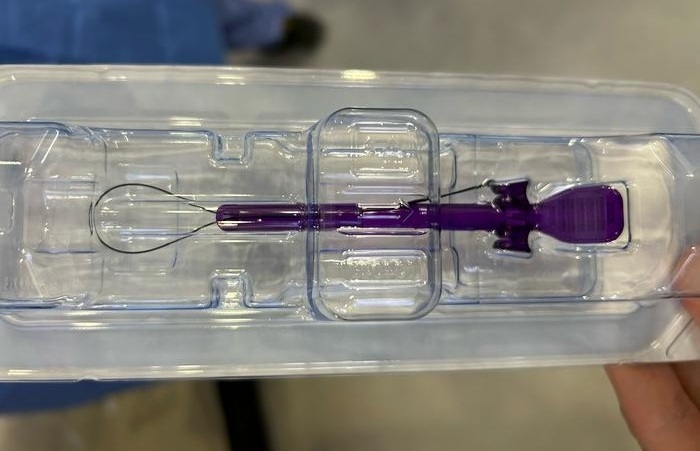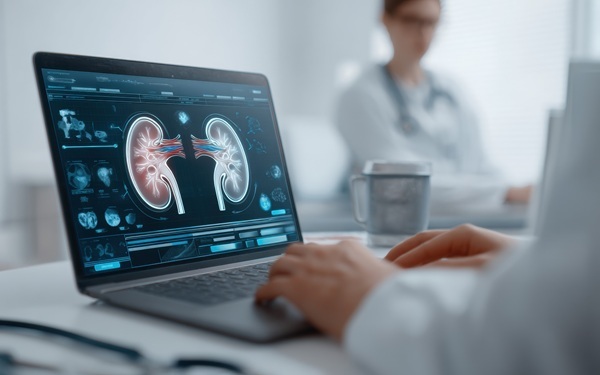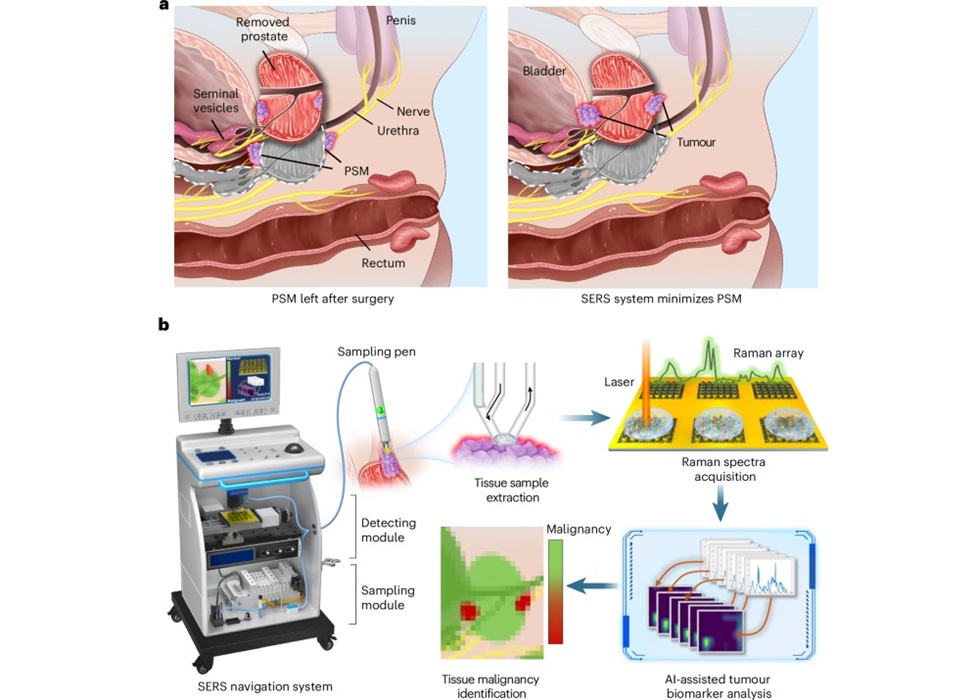Clay Preparations Destroy Antibiotic-Resistant Bacteria
|
By HospiMedica International staff writers Posted on 30 Jul 2014 |

Image: French green clays used for healing Buruli ulcers (Photo courtesy of Thierry Brunet de Courssou/ASU).
Natural clay deposits with antibacterial properties could provide a possible solution for killing pathogens resistant to multiple antibiotics.
Researchers at Arizona State University (ASU; Phoenix, USA) set out to identify naturally-occurring clays that are effective at killing antibiotic-resistant bacteria. The scientists examined mineralized clay deposits near Crater Lake (OR, USA), in an area mined by Oregon Mineral Technologies (OMT; Jackson, USA). The clay, formed by volcanic activity millions of years ago, had turned into bluish clay known as K Rectorite. The clay contains over 40 minerals, including silicon, aluminum, iron, potassium, magnesium, calcium, sodium, manganese, sulfur, and phosphate.
The researchers hypothesized that the clays buffer pH (acidity)and Eh (oxidation) to dissolve unstable mineral phases containing transition metals (primarily Fe2+), while smectite interlayers serve as reservoirs for time release of bactericidal components. They then incubated the pathogens Escherichia coli and Staphylococcus epidermidis with clays from different zones. They found that rapid uptake of Fe2+ impaired bacterial metabolism by flooding the cell and overwhelming iron storage proteins. As the intracellular Fe2+ oxidized, it produced reactive oxygen species that damage biomolecules and precipitates Fe-oxides. The study was published in the August 2014 issue of Environmental Geochemistry and Health.
“As antibiotic-resistant bacterial strains emerge and pose increasing health risks, new antibacterial agents are urgently needed. Antibacterial clays may shift the wound environment to a pH range that favors healing, while killing invading bacteria,” said senior author biogeochemist Lynda Williams, PhD. “The ability of antibacterial clays to buffer pH also appears key to their healing potential and viability as alternatives to conventional antibiotics.”
Green clays, historically used in France in mineral baths, have been used to treat Mycobacterium ulcerans, the pathogen that causes Buruli ulcers. The infections, which lead to the destruction of skin and large, open ulcers on arms or legs, can be treated with daily applications of green clay poultices to heal the infections. Unfortunately, the original French green clays have been depleted, and later testing of newer samples did not show the same results.
Related Links:
Arizona State University
Oregon Mineral Technologies
Researchers at Arizona State University (ASU; Phoenix, USA) set out to identify naturally-occurring clays that are effective at killing antibiotic-resistant bacteria. The scientists examined mineralized clay deposits near Crater Lake (OR, USA), in an area mined by Oregon Mineral Technologies (OMT; Jackson, USA). The clay, formed by volcanic activity millions of years ago, had turned into bluish clay known as K Rectorite. The clay contains over 40 minerals, including silicon, aluminum, iron, potassium, magnesium, calcium, sodium, manganese, sulfur, and phosphate.
The researchers hypothesized that the clays buffer pH (acidity)and Eh (oxidation) to dissolve unstable mineral phases containing transition metals (primarily Fe2+), while smectite interlayers serve as reservoirs for time release of bactericidal components. They then incubated the pathogens Escherichia coli and Staphylococcus epidermidis with clays from different zones. They found that rapid uptake of Fe2+ impaired bacterial metabolism by flooding the cell and overwhelming iron storage proteins. As the intracellular Fe2+ oxidized, it produced reactive oxygen species that damage biomolecules and precipitates Fe-oxides. The study was published in the August 2014 issue of Environmental Geochemistry and Health.
“As antibiotic-resistant bacterial strains emerge and pose increasing health risks, new antibacterial agents are urgently needed. Antibacterial clays may shift the wound environment to a pH range that favors healing, while killing invading bacteria,” said senior author biogeochemist Lynda Williams, PhD. “The ability of antibacterial clays to buffer pH also appears key to their healing potential and viability as alternatives to conventional antibiotics.”
Green clays, historically used in France in mineral baths, have been used to treat Mycobacterium ulcerans, the pathogen that causes Buruli ulcers. The infections, which lead to the destruction of skin and large, open ulcers on arms or legs, can be treated with daily applications of green clay poultices to heal the infections. Unfortunately, the original French green clays have been depleted, and later testing of newer samples did not show the same results.
Related Links:
Arizona State University
Oregon Mineral Technologies
Latest Critical Care News
- Magnetically Guided Microrobots to Enable Targeted Drug Delivery

- Smart Nanomaterials Detect and Treat Traumatic Brain Injuries Simultaneously
- Earlier Blood Transfusion Could Reduce Heart Failure and Arrhythmia in Heart Disease Patients
- 'Smart' Shirt Detects Epileptic Seizures in Real Time
- Skin Patch Measures Effectiveness of Flu/COVID Vaccines in 10 Minutes
- Complete Revascularization Reduces Risk of Death from Cardiovascular Causes
- Tiny Fish-Inspired Robots Navigate Through Body to Deliver Targeted Drug Therapy
- Coronary Artery Stenosis Could Protect Patients from Pulmonary Embolism Effects
- Sweat-Powered Sticker Turns Drinking Cup into Health Sensor
- Skin-Mounted 3D Microfluidic Device Analyzes Sweat for Real-Time Health Assessment
- New Therapeutic Brain Implants to Eliminate Need for Surgery
- Stem Cell Patch Gently Heals Damaged Hearts Without Open-Heart Surgery
- Biomaterial Vaccines to Make Implanted Orthopedic Devices Safer
- Deep Learning Model Predicts Sepsis Patients Likely to Benefit from Steroid Treatment
- Programmable Drug-Delivery Patch Promotes Healing and Regrowth After Heart Attack
- Breakthrough Ultrasound Technology Measures Blood Viscosity in Real Time
Channels
Surgical Techniques
view channel
New Study Findings Could Halve Number of Stent Procedures
When a coronary artery becomes acutely blocked during a heart attack, opening it immediately is essential to prevent irreversible damage. However, many patients also have other narrowed vessels that appear... Read more
Breakthrough Surgical Device Redefines Hip Arthroscopy
Hip arthroscopy has surged in popularity, yet surgeons still face major mechanical constraints when navigating deep joint spaces through traditional cannulas. Limited tool mobility and the need for an... Read morePatient Care
view channel
Revolutionary Automatic IV-Line Flushing Device to Enhance Infusion Care
More than 80% of in-hospital patients receive intravenous (IV) therapy. Every dose of IV medicine delivered in a small volume (<250 mL) infusion bag should be followed by subsequent flushing to ensure... Read more
VR Training Tool Combats Contamination of Portable Medical Equipment
Healthcare-associated infections (HAIs) impact one in every 31 patients, cause nearly 100,000 deaths each year, and cost USD 28.4 billion in direct medical expenses. Notably, up to 75% of these infections... Read more
Portable Biosensor Platform to Reduce Hospital-Acquired Infections
Approximately 4 million patients in the European Union acquire healthcare-associated infections (HAIs) or nosocomial infections each year, with around 37,000 deaths directly resulting from these infections,... Read moreFirst-Of-Its-Kind Portable Germicidal Light Technology Disinfects High-Touch Clinical Surfaces in Seconds
Reducing healthcare-acquired infections (HAIs) remains a pressing issue within global healthcare systems. In the United States alone, 1.7 million patients contract HAIs annually, leading to approximately... Read moreHealth IT
view channel
EMR-Based Tool Predicts Graft Failure After Kidney Transplant
Kidney transplantation offers patients with end-stage kidney disease longer survival and better quality of life than dialysis, yet graft failure remains a major challenge. Although a successful transplant... Read more
Printable Molecule-Selective Nanoparticles Enable Mass Production of Wearable Biosensors
The future of medicine is likely to focus on the personalization of healthcare—understanding exactly what an individual requires and delivering the appropriate combination of nutrients, metabolites, and... Read moreBusiness
view channel
Philips and Masimo Partner to Advance Patient Monitoring Measurement Technologies
Royal Philips (Amsterdam, Netherlands) and Masimo (Irvine, California, USA) have renewed their multi-year strategic collaboration, combining Philips’ expertise in patient monitoring with Masimo’s noninvasive... Read more
B. Braun Acquires Digital Microsurgery Company True Digital Surgery
The high-end microsurgery market in neurosurgery, spine, and ENT is undergoing a significant transformation. Traditional analog microscopes are giving way to digital exoscopes, which provide improved visualization,... Read more
CMEF 2025 to Promote Holistic and High-Quality Development of Medical and Health Industry
The 92nd China International Medical Equipment Fair (CMEF 2025) Autumn Exhibition is scheduled to be held from September 26 to 29 at the China Import and Export Fair Complex (Canton Fair Complex) in Guangzhou.... Read more














